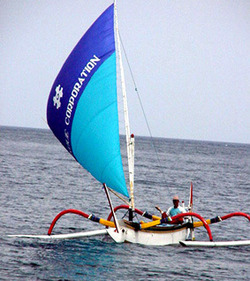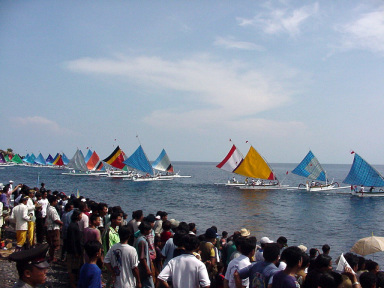On October 11th, fishermen will set off into the wind with multi-hued sails, competing each other for a coveted prize. It's for precious money to feed their families and serve community needs. Simon Pridmore gives us the history behind the fascinating Jukung Race, and tells how we can help boost the income of the poor.
In 1963 Bali’s largest volcano, Gunung Agung, erupted majestically, lava pouring down its flanks into the ocean.
As the lava stream crossed the beach before it extinguished itself in the sea, it picked up the Liberty, an American freighter which had lain abandoned on the sand for twenty years, and deposited it 50 metres further to the north and 30 metres below the surface of the Bali Sea.

Mt Agung in northeast
Bali stands tall even in the dry season.At the time, you could never have predicted that this particular single violent act of nature would have created a whole new world for the people of the desperately poor village of Tulamben who had just seen everything they owned and knew engulfed by the lava flow.
At around the same time scuba-diving was becoming an increasingly popular sport in Europe and the USA popularised by the real life adventures of Jacques Cousteau and his crew and the fictitious adventures of Lloyd Bridges in the TV show Seahunt.

Corporations can do their bit by setting off a sail.
Fast forward several decades to today; scuba diving is now a sport practised by millions worldwide and Indonesia has found fame as the crucible of life, ground zero as far as species diversity is concerned. The Liberty has been taken over by marine life, covered in coral and home to millions of fish, large and small. Divers from all over the world flock to Tulamben to dive the wreck and the undulating black sand slopes around her.
Dive centres, hotels, resorts, restaurants and shops have been built all along a three kilometre section of road close to the coast to cater to the increasing demand. Young men from the village and the surrounding area have been trained by the resorts as instructors and dive-masters and, armed with their knowledge and sharp eyes, they guide visitors around the wreck pointing out the hard-to-find sea creatures that dwell within and around, ghost pipefish, pigmy sea-horses, frog-fish, nudibranchs and myriad other rare animals that divers will travel thousands of miles to see.
The more entrepreneurial of the young local men have opened their own little businesses down by the shore line to provide services to independent travellers drawn to the area by the wreck. They rent out equipment, fill scuba cylinders and offer guided tours. Some have set up small “warung makan”, little local cafes, in makeshift parking lots to serve lunch to visitors in between dives.
Owners of small fishing sailing vessels known as jukung have converted their boats to take divers on board and have learned where the best sites are and how to track bubbles. Even the old women of Tulamben have adapted the skills they were born with to earn a living as porters. Carrying two full sets of dive equipment on their heads, they present an improbable sight as they pick their way gracefully along the stony shore and deposit their load by the water line to make it easier for divers to begin their dives safely.

Wind in their hair, money in some hands.
The hotels and resorts provide employment as does the mini building boom that is taking place now as beach-front land is bought up by investors and villas start to dot the coast line. The climate here is hot and dry but the sea breezes mitigate the heat and increasing numbers of expatriates are fleeing the busy roads and choked infrastructure of the south, preferring the peace and quiet of the north. As the road system provides convenient access to Amalapura and Candidasa, Tulamben and the area around the village is becoming a preferred destination; all of which brings increased affluence to the villagers, whose survival would be otherwise threatened by the diminished returns from fishing in recent years as stocks have become depleted.
In an effort to try to encourage a few more Bali tourist dollars to be spent north of Ubud and to provide additional income for the fishermen, one resort organised Jukung races in 2000 and 2001 in conjunction with the local Fishery Bureau, the Water Police Department and the Bali Tourism Bureau. However, the Kuta bar bombings and consequent effect on tourism throughout the island discouraged them from continuing the programme of races until this year when they are being revived.
On October 11th, the Emerald Tulamben Hotel and Spa will host the 2009 Jukung Race with the support of companies and individuals who are sponsoring both the event and individual boats. The proceeds of this sponsorship will be used for prizes and the remainder passed on to the fishing community.
For further information see www.tulambenbali.com or contact jukung2009@tulambenbali.com
Mount Agung photography by Simon Pridmore, jukungs by Thomas Inoue.
Support the exciting Jukung Race event with a USD50 donation that will be used as prize money for participating fishermen. Companies can also display their logos for USD120, which will be on display, plying the winds for a year.